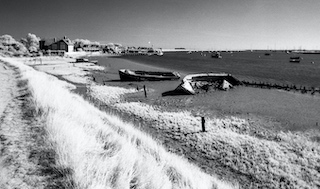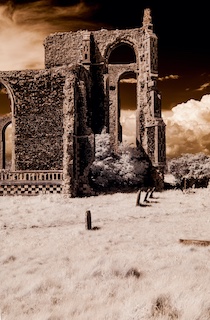This page gives links to material relevant to Infra-red photography. Infra red photography is best achieved on bright sunny days with some clouds in the sky for contrast. Blue sky and water will come out very dark but anything growing reflects infra red light and comes out very pale almost whitish.
- Digital Photography School
- Kolari
- Expert Photography
- Advanced Camera Services – Repairs, UV / IR conversion
Unfortunately there are no colour print or reversal infra red films available.
However, black and white print films are available. Rollei 400 Infrared and Ilford SFX200 give good results. A 720nm infra red filter is needed. This only allows infra red light through, so you have to focus without the infra red filter and use a suggested f/8 aperture and take a shutter speed reading. Putting on the infra red filter, the exposure needs to be increased by 5 stops, but it may be necessary to experiment a little. Both films can be processed at any lab that does BW negatives.

A digital alternative is to have an older, less used digital camera permanently converted to infra red. This involves removal of the internal infra red bypass filter, thus making the camera capable of taking infra red images. The advantage of a converted digital camera is that it can be used at f/8 in aperture priority mode and shutter speeds will be reasonably fast, so this type of camera can be hand held.

Although results are extremes of dark and light, the colours can be manipulated in image processing software.
